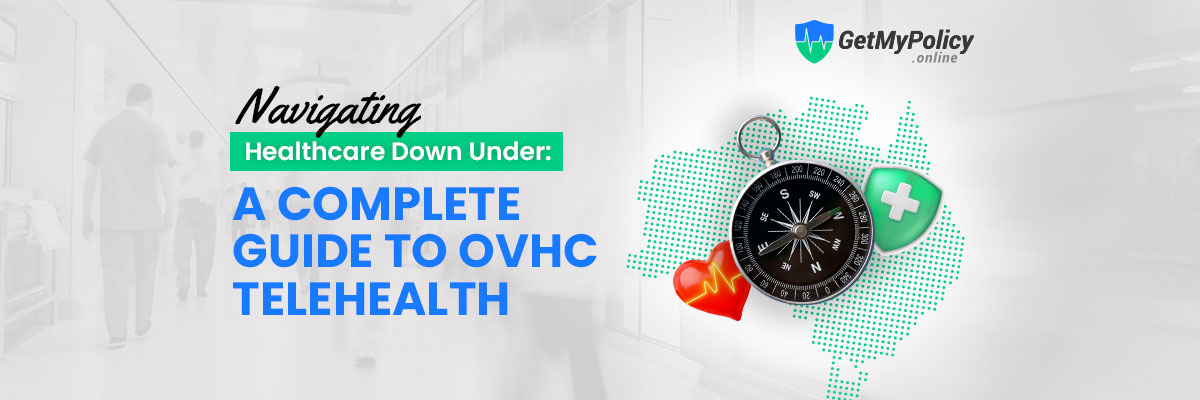Why OVHC Telehealth Matters for Remote Workers in Australia?
Why is OVHC with telehealth critical for healthcare access among workers in Australia?
- Many temporary visa holders are not eligible for Medicare (Australia’s public health system). OVHC provides private health cover designed for that gap.
- Telehealth allows virtual consultations (via video or phone), enabling access to GPs, referrals, prescriptions, or mental health support without travel-vital in remote or regional areas.
- It helps you remain productive and compliant: you don’t need to pause work to commute for minor illnesses.
- In many visa types, including those subject to condition 8501, maintaining adequate health cover is a visa requirement-OVHC helps you satisfy that.
OVHC Telehealth as Your Path to Flexible Healthcare
With telehealth as part of an OVHC plan, you may enjoy benefits like:
- 24/7 access or extended hours (depending on provider)
- No-gap or low-gap telehealth GP consults with approved or in-network doctors
- Ability to request repeat prescriptions, get referrals, or receive medical certificates
- Reduced travel time and cost, especially crucial in remote towns
What Is OVHC and Telehealth in Australia?
What is OVHC, and how does telehealth supplement it?
- OVHC (Overseas Visitors Health Cover) is private health insurance tailored for those ineligible for Medicare (e.g. many visa holders). It covers costs that Medicare would normally support: doctor visits, hospital treatment, ambulance services, and more - subject to plan levels and inclusions.
- Telehealth under OVHC refers to virtual consultations (video, phone, or online GP services) provided by Australian-registered doctors, with coverage (fully or partially) under the OVHC plan when conducted through approved channels.
- Telehealth is not a separate insurance; it is a mode of service access under your OVHC policy or linked digital health add-ons.
Scope and Differences by Plan Tier
- Basic/entry-level OVHC plans may only include limited hospital and essential medical coverage, with no or restricted telehealth benefits.
- Mid/standard or premium plans are more likely to include or reimburse telehealth GP visits, mental health consults, or referrals.
- Some providers include extra features like 24/7 telehealth, no-gap telehealth, or digital health add-ons.
- Telehealth under OVHC typically covers non-emergency, general medical issues (e.g. flu, skin conditions, mental health check-ins). It is rarely allowed for acute emergencies or where in-person care is medically required.
Who Can Apply for OVHC with Telehealth Coverage?
Who is eligible for OVHC and telehealth under OVHC in Australia?
- Temporary visa holders who are not eligible for Medicare-for example, holders of visas such as 482 (Temporary Skill Shortage), 417/462 (Working Holiday), 485 (Temporary Graduate), 600 (Visitor), 408, 494, or bridging visas-are typical OVHC candidates.
- Some visas are subject to condition 8501, which mandates “adequate health insurance” for the visa duration-OVHC is used to satisfy that for many visa subclasses.
- OSHC vs. OVHC: Students under subclass 500 often must maintain OSHC (Overseas Student Health Cover) rather than OVHC. Providers like ahm, Allianz Care, Bupa, Medibank, nib also offer OSHC plans.
- Age or health-related restrictions: Some entry-level plans may restrict eligibility by age (e.g., under 50) or impose waiting periods or exclusions for pre-existing conditions.
- Telehealth access requirements: To use telehealth, you usually need an active OVHC policy with telehealth enabled (or digital health addon) and use approved telehealth providers within your insurer’s network.
- Family and dependents: Many OVHC policies allow including family members, though telehealth inclusion for dependents may vary or incur additional cost.
Documents Required to Apply for OVHC and Access Telehealth Services
What documents do you need to apply for OVHC?
- Visa details: visa subclass, grant letter or visa grant notice
- Passport and identity documentation
- Residential address in Australia (or intended address)
- Health declaration / pre-existing condition disclosure
- Payment information (credit card, direct debit)
- If switching from OSHC to OVHC or modifying coverage, you may also need your current policy/membership ID
What documents are needed to use telehealth under OVHC or lodge telehealth claims?
- OVHC membership number / policy certificate
- Proof of identity (passport, driver’s license)
- Medical history / current medications if requested by the telehealth doctor
- Electronic prescription requirements: some systems require your Individual Healthcare Identifier (IHI) if prescribing medicine in Australia (as with some telehealth providers)
- Receipt or invoice from the telehealth consultation showing date, provider, item code (if MBS / insurer claimable)
- Referral documents if required for specialist claims
Processing Times and Costs for OVHC Policies and Telehealth Claims
Processing times for OVHC policies
- Many insurers offer instant quotes and instant electronic certificates upon payment (i.e. same day activation) for standard OVHC policies.
- Formal paperwork or underwriting (if high-risk, pre-existing conditions) may take several days in rare cases
- Once active, you’re eligible to use covered services subject to waiting periods
Typical costs / premium ranges
- OVHC premiums vary by provider, visa subclass, coverage level, age, excess, and duration
- Entry-level OVHC plans often start around AUD 60–100 per month depending on coverage and visa type.
- For example, Allianz’s Budget Visitors Cover offers hospital cover from ~AUD 163.60/month for visa 600 (with high excess).
- More comprehensive plans (hospital + extras + telehealth benefits) can cost significantly more, perhaps AUD 120–200+ per month
- Some insurers require first month premium paid upfront to activate the policy (e.g. Bupa)
- Telehealth claim / consultation costs and processing
- In many cases, telehealth GP consults are fully covered or “no-gap” if delivered via the insurer’s approved telehealth provider (e.g. Allianz’s Doctors on Demand)
- If you use a telehealth service outside the insurer’s network or one not recognized, you may pay the full fee and lodge a claim (which may only partially reimburse you)
- Claims processing for telehealth services is typically 10–14 business days, depending on insurer and completeness of documentation
- Some policies may limit the number of telehealth consults per year or impose waiting periods for mental health or specialist telehealth services
Common Challenges or Limitations When Accessing Telehealth under OVHC
What are common hurdles and limitations?
- Limited scope / not for emergencies
Telehealth is meant for non-emergency consultations. If symptoms are severe (chest pain, major injuries), you must seek in-person care or emergency services, which may be excluded from telehealth cover. - Provider network restrictions
Only consultations with approved telehealth providers or in-network doctors are fully covered with no-gap terms. Outside providers may not be reimbursed fully or at all. - Waiting periods and exclusions
Some policies impose waiting periods for telehealth access (especially for mental health, specialist telehealth) or exclude pre-existing conditions entirely for telehealth coverage. - Claim rejections or gaps
Claims may be rejected if:- Service is not listed under insurer’s telehealth benefit
- Invoice lacks correct item codes or provider details
- You used a non-approved provider
- You did not present proof of membership or identity
- The service isn’t part of the plan’s inclusions
- Prescription limitations
In certain cases, doctors may decline to issue prescriptions via telehealth for complex or controlled medications or require an in-person follow-up. - Policy lapses / continuity
Gaps in policy coverage (e.g. forgetting to renew) may cause telehealth benefits to be withheld or claims rejected.
What to do if your telehealth claim is refused?
- Request the insurer’s explanation and review policy wording
- Resubmit the claim with missing documentation (receipts, item codes, provider credentials)
- Appeal through insurer’s internal dispute process
- If persistent issues, consider switching to a plan/provider with better telehealth network coverage
How to Apply for OVHC and Use Telehealth Services as a Worker in Australia?
Here’s a step-by-step guide:
Step 1: Confirm your visa requirements
- Check whether your visa is subject to condition 8501 (adequate health insurance requirement) via the Department of Home Affairs
- If yes, you need a policy covering hospital, medical/MBS, ambulance, medication coverage at minimum
Step 2: Compare OVHC plans with telehealth features
- Consider providers: Allianz Care, Bupa, Medibank, nib, AIA
- Check if the provider has an integrated telehealth product (e.g. Allianz’s “Doctors on Demand”)
Step 3: Gather your documents
- Visa grant letter, passport, proof of address
- Health declaration and any pre-existing condition info
- Payment details
Step 4: Apply online and pay premium
- Many insurers allow instant quoting and online purchase
- Upon successful payment, you’ll get a Certificate of Insurance or membership number-often immediately
- Set your policy start date (usually matching visa grant or arrival)
Step 5: Activate telehealth access
- If your plan includes telehealth, log in to the insurer’s portal or telehealth partner (e.g. Doctors on Demand)
- Register your details, membership, and IHI if needed
- Download any relevant app (e.g. Allianz’s MyHealth / OMS)
Step 6: Book or request a virtual doctor visit
- Choose between “see a doctor now” or schedule a time
- Provide relevant medical history and symptoms
- After consultation, you may receive a digital prescription, referral, or medical certificate
Step 7: Submit claims (if needed)
- If telehealth was no-gap via insurer’s partner, you may not need a claim
- If you paid out-of-pocket, submit invoice, claim form, membership and identity proof
- Wait 10–14 days for reimbursement
Step 8: Maintain continuous coverage
- Ensure premiums are paid on time to avoid policy lapse
- Review inclusion of telehealth in any renewals
- Monitor usage and remaining telehealth consult entitlements
OVHC Telehealth Comparison Table
Below is a comparison of key telehealth features among leading OSHC/OVHC providers (note: details are indicative and may vary by specific plan). Always check the policy’s product disclosure statement (PDS) for exact terms.
| Provider |
Telehealth Feature /
Provider |
24/7 Virtual GP |
No-gap telehealth
(in-network) |
Prescription/referrals via telehealth |
Waiting periods or exclusions |
Notes & caveats |
| Allianz Care (OSHC / OVHC) |
Through Doctors on Demand |
Available 24/7 |
For Standard, Mid, Top plans (excluding “Budget” covers) |
Yes, e-scripts & referrals |
Excludes telehealth in “Budget Working” / “Budget Visitors” plans |
You must maintain active cover and use their telehealth system |
| Bupa (OVHC / OSHC) |
Uses Blua / Bupa digital health services |
24/7 online doctors (subject to limits) |
Likely, for in-network providers |
Yes, for general consults; specialist telehealth subject to plan |
Yearly service limits and insurer rules apply |
Some consult types (e.g. specialist) may not be bookable via app |
| Medibank (OVHC / OSHC) |
OVHC “Visitors” plan + digital health options |
Telehealth via Medibank’s digital services |
May include in certain tiers |
General telehealth consults supported |
Depends on plan and waiting periods |
For non-visa OSHC, telehealth may be part of extras depending on plan |
| nib (OVHC) |
Health cover meeting visa 8501, may offer telehealth |
Dependent on plan |
If provider in network |
Likely for general consults |
Based on plan inclusions and waiting periods |
Must check specific OVHC plan wording |
| AIA (OVHC) |
Listed as OVHC provider in Australia |
Dependent on AIA’s digital health offerings |
Dependent on plan |
Likely but check plan terms |
Likely exclusions for pre-existing conditions |
Less publicly detailed - confirm with AIA directly |
| ahm (OSHC) |
OSHC provider (student cover) |
Possibly via OSHC digital health |
As per OSHC plan network |
For general consults |
OSHC may have stricter limits for non-students |
Telehealth is more common in OSHC add-ons |
Note: The above table is a general guide. Always refer to the policy disclosure document (PDS) from each insurer to see exact telehealth inclusions, eligible providers, service limits, waiting periods, and exclusions.





.svg)
.svg)
.svg)


